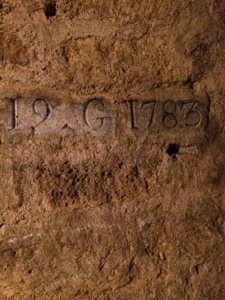The map shows the extent of the tour that is open. The dotted orange line is the long assess tunnel through the quarry area to the area where the remains are laid to rest (the black lines).
The long tunnel we walked to access the ossorary.
The black line was drawn on the ceiling in the earliest days when tours occurred (when there was not electricity - talk about a freaky experience). We were curious how it was painted on since there was not spray paint back then.
The support columns were blocks of stone (seen in shadow), or unmortared walks keeping back the dirt and debris (in the background).
There were dates inserted in the walls by the inspectors and companies that did the support work throughout the quarry (this one days to 1783)
This iis the actual entry to the burial part of the complex. "Stop. This is the Emire of the Dead".
Skulls stacked in rows on top of tightly piled leg and arm bones (not sure where the smaller bones ended up).
Each room had a sign that noted which cemetary the remains had come from. These were from St. Jean and deposited in the catacombs in 1859.
I liked this picture because you could see how the quarry men worked the ceiling as well as the bones that were stacked later.
There were some pretty significant cave ins that this picture models.










No comments:
Post a Comment